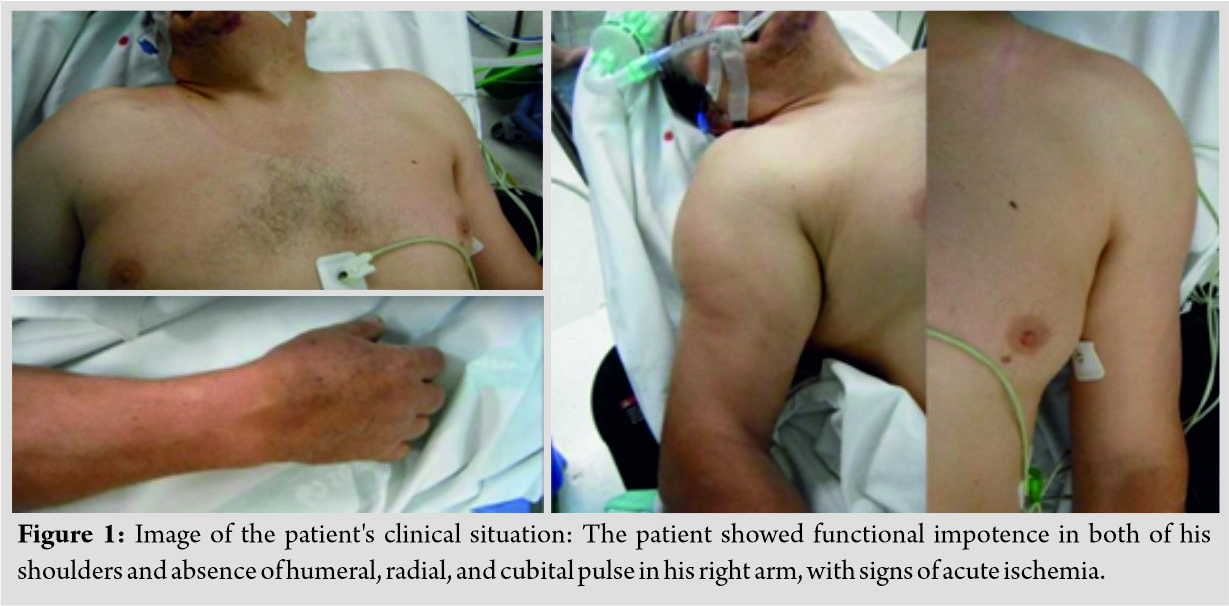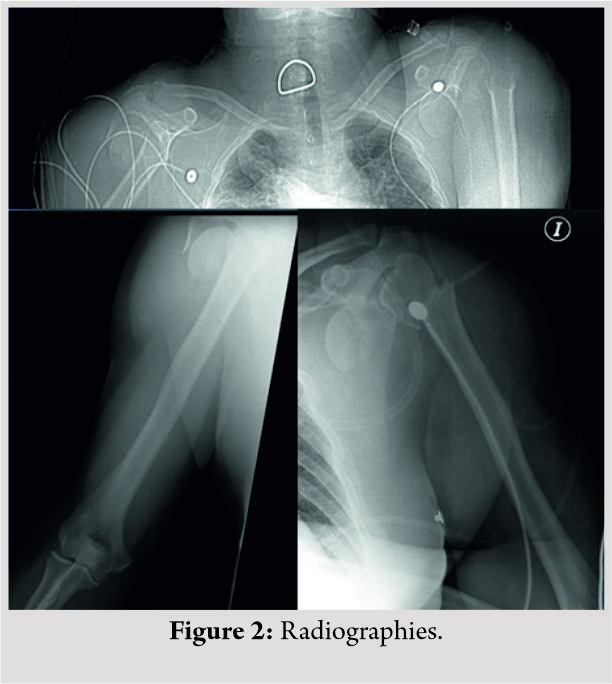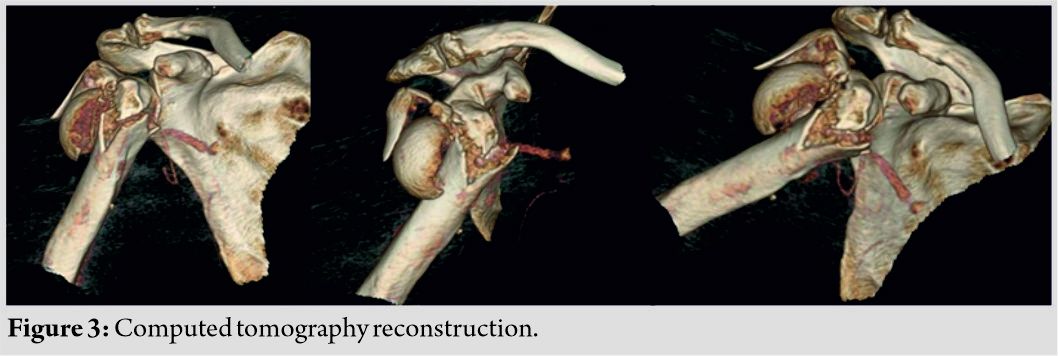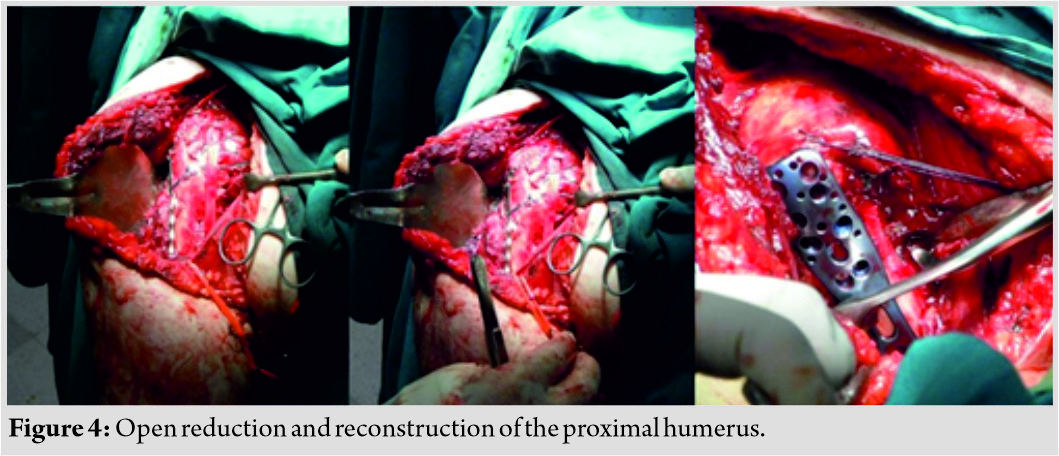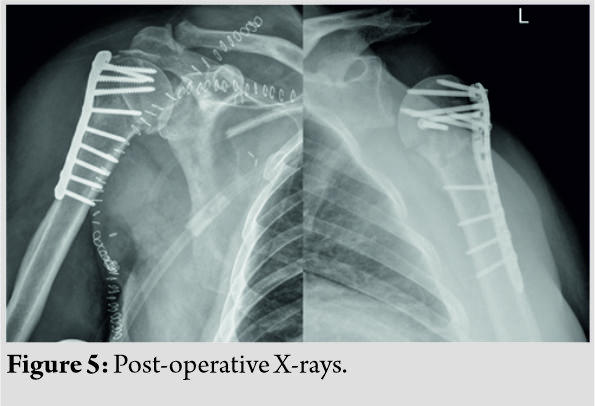[box type=”bio”] Learning Point of the Article: [/box]
The simultaneous bilateral fracture and dislocation with axillary artery injury secondary happen very rarely and it is seldom related to a trauma. An injury to the axillary artery related to a humerus fracture is an exceptional event. The treatment for these complex injuries requires a multidisciplinary surgical approach. To treat these injuries, an early diagnose is essential regarding the fact that the prognosis is directly related to the time elapsed without blood circulation. That is why it is necessary to look for these arterial injuries in case of a proximal humerus fracture.
Case Report | Volume 10 | Issue 1 | JOCR January – February 2020 | Page 26-29 | Javier Cervera Irimia, David Gómez Garrido, Michele Bisaccia, Giuseppe Rollo, Luigi Meccariello, Félix Tomé-Bermejo. DOI: 10.13107/jocr.2020.v10.i01.1624
Authors: Javier Cervera Irimia[1], David Gómez Garrido[1], Michele Bisaccia[2], Giuseppe Rollo[3], Luigi Meccariello[3], Félix Tomé-Bermejo[1]
[1]Department of Orthopaedic Surgery and Traumatology, Villalba General Hospital, Madrid, Spain,
[2]Department of Orthopedics and Trauma Surgery, University of Perugia, “S. Maria Della Misericordia” Hospital, Perugia, Italy,
[3]Department of Orthopedics and Traumatology, Vito Fazzi Hospital, Lecce, Italy.
Address of Correspondence:
Dr. Luigi Meccariello,
Department of Orthopedics and Traumatology, Vito Fazzi Hospital, Piazzetta Muratore, Block: A-Floor:V, Lecce, Italy.
E-mail: drlordmec@gmail.com
Abstract
Introduction: Among all of the shoulder dislocation cases, only 1% is related to fractures. The simultaneous bilateral fracture and dislocation happen very rarely and it is seldom related to a trauma. An injury to the axillary artery related to a humerus fracture is an exceptional event.
Case Report: A 58-year-old male with no particular background who, after falling from a 5 m height, presented a fracture and dislocation of both of his shoulders and showed no pulse in his right arm due to an injury to his axillary artery. The peculiarity of this injury increases when the axillary artery injury is added to the bilateral fracture and luxation of the humerus. We present the case and revise literature.
Conclusion: The treatment for these complex injuries requires a multidisciplinary surgical approach. To treat these injuries, an early diagnose is essential regarding the fact that the prognosis is directly related to the time elapsed without blood circulation. That is why it is necessary to look for these arterial injuries in case of a proximal humerus fracture.
Keywords: Fracture, bilateral, humerus, axillary artery injury.
Introduction
Proximal humerus fractures are common injuries that represent between 2% and 3% of all the fractures in upper limbs. What is really unusual is to find a bilateral proximal humerus fracture and dislocation caused by trauma [1]. Injuries of the brachial artery in supracondylar humerus fractures are more or less frequent [2]; nevertheless, the injury to the axillary artery due to a fracture of the proximal humerus is very unusual, usually published as part of a report of isolated cases or case series including very few patients [3, 4]. Its estimated frequency related to glenohumeral dislocation is below 1% and seems to be even lower when we talk about humerus fractures [5].
The exceptionality of these cases resides in the concomitance of two injuries that are very rare separately and it is even more unusual to find them simultaneously, as it happens with the injury of the axillary artery and the bilateral proximal humerus fracture with dislocation.
After suffering a trauma, the artery could be tear, contuse, clot, or generate a spasm. These complications may have serious consequences (traumatic aneurysm, acute ischemia, gangrene, ischemic nerve paralysis, and compartmental syndrome) that might motivate dramatic situations for the patient [3, 6], and that is why a fast diagnoses and an effective treatment are required. The morbidity and mortality related to these kinds of injuries range from 5% to more than 30% according to several researches [7, 8].
The usefulness of an arteriography in a patient with a humerus fracture is controverted, even though most of the authors recommend it in case of suspecting the presence of a vascular injury [9, 10]. Hence, it is pretty important to have a proper knowledge of the vascular anatomy to assess the possibility and seriousness of the injury [10] and, due to its complexity, it requires the multidisciplinary management in close cooperation between the orthopedic surgeon and the vascular surgeon [11, 12].
We present the case of a simultaneous bilateral fracture-dislocation of the humerus in concomitance with a right axillary artery injury.
Case Report
A 58-year-old male with no particular background who, after falling from a 5m height, reported pain and restriction of movement on both shoulders and loss of sensibility and movement in his right arm. The patient showed functional impotence, not being able to perform adduction and internal rotation with both upper limbs, evident ecchymosis in both of his shoulders and absence of humeral, radial, and cubital pulse in his right arm, with signs of acute ischemia (coldness, paleness, diminished sensibility, and motor function of the elbow and the hand), with no capillary filling in the right hand. Oxygen saturation, measured with a pulse oximeter, could not be measured in the right index finger in comparison with 99% in the left one (Fig. 1). Radiographies and computed tomography showed a fracture-dislocation of the proximal front humerus in both of the shoulders (Fig. 2). A Doppler could not find distal pulse in the right upper limb, so the patient was immediately remitted to surgery. In the surgical room and under general anesthesia, an emergency arteriography was carried out through transfemoral access, and a tear in the intima of the right axillary artery was found, being that the reason why an emergency intervention was indicated. Then, through deltopectoral path, we proceeded to perform an open reduction and internal fixation using a pre-molded plaque of the proximal humerus (Fig. 3). After that, an auto-expandable stent was implanted and a bypass graft with interposition of the great saphenous was performed by the service of angiology and vascular surgery (Fig. 4). Finally, a distal embolectomy with a Fogarty catheter was performed to eliminate any thrombus. The control arteriography proved vascular permeability. Four days after the emergency surgery, the left shoulder was operated again through deltopectoral path, performing an open reduction and internal fixation with a pre-molded plaque of the proximal humerus. The patient was discharged several days after the humeral, radial, and cubital pulses were recovered in the right upper limb. Antiplatelet therapy with clopidogrel was indicated. In the follow-up, the patient shows an acceptable range of mobility with 50° of flexion and 40° of abduction in the right shoulder and 60° of flexion and 30° of abduction in the left shoulder. The patient has recovered sensibility, strength, and mobility in the hand and the vascularization of the upper right limb is correct in the Doppler. Radiology shows signs of consolidation in the fractures with no images of avascular necrosis (Fig. 5).
Discussion
The exceptionality of the case resides in the concomitance of two unusual injuries: The bilateral fracture-dislocation, simultaneous and comminute, of the proximal humerus and the injury to the right axillary artery. The anterior fracture-dislocation of the proximal humerus is seldom and the reasons can be deduced when analyzing the mechanism that produces the injury, caused by the fulcrum exerted by humerus head when the greater tuberosity has an impact on the acromion in the position of abduction, extension, and external rotation. It happens frequently in falls with the arms extended, but it is not frequent to be bilateral due to the fact that the trauma is produced first in an arm and the contralateral limb is adduced and rotates internally as a protection mechanism [12, 13, 14, 15, 16]. In general, an electric shock continues to be the most common cause for any bilateral shoulder dislocation and literature has reported very few cases with a traumatic etiology [16]. The injury to the axillary artery as a result of a proximal humerus fracture is a rare complication [3, 4]. Usually, the diagnosis is suspected by the clinical picture. The most common signs of the axillary artery injury are the absence of peripheral pulses and evident ischemia signs as coldness, paleness, cyanosis, paresthesia, and sensitive and motor function decreasing [13]. However, it is necessary to remember that during the first physical examination, the collateral circulation of the shoulder may demonstrate the absence of symptoms with palpable pulse in the limbs, even though there is a change of an injury to the axillary artery [3, 12]. That is why it is important to control the vascular status during the evolution [14]. Due to the anatomical proximity, in these cases may appear signs of median, radial and cubital nerves involvement [14]. If arterial and distal pulses are not evident and the vascularization is not clear, in the suspicion of a possible vascular injury, an emergency arteriography must be indicated [5, 12, 14]. The arteriography increases the time elapsed from the moment, in which the patient arrives to the emergency room until the surgical intervention is performed, but when performed previous to surgery, it facilitates the precise localization of the injury, giving some important information about the magnitude of it and it is also useful to rule out other injuries [9, 10]. The management of these complex injuries requires a multidisciplinary treatment. The approach depends on the kind of injury. First of all, it seems to be imperative to reduce and stabilize the fracture or dislocation that produced it [14]. Only in a situation of hemodynamic instability caused by an active bleeding that might put patient’s life in risk, it would be necessary to invert the process and start by treating the vascular injury [14]. In the case of an arterial injury with total or partial laceration, a direct suture – if possible – is indicated. In the case of a tearing of the intima and thrombus, the treatment consists in the reconstruction of the artery with a resection of the affected area and the substitution using a bypass, preferable with an inverted venous graft from the inner saphenous [3, 14]. The endovascular treatment of contusions in the axillary artery is an effective alternative to the conventional surgery and it shows good results in certain cases [15]. To treat these kinds of injuries, the premature diagnose is a must, due to the fact that the prognosis is directly related to the time elapsed before restoring the circulation to the limb. This situation makes it necessary to maintain a high level of suspicion in the presence of a proximal humerus fracture.
Conclusion
The treatment for these complex injuries requires a multidisciplinary surgical approach. To treat these injuries, an early diagnose is essential regarding the fact that the prognosis is directly related to the time elapsed without blood circulation. That is why it is necessary to look for these arterial injuries in case of a proximal humerus fracture.
Clinical Message
The bilateral fracture-dislocation, simultaneous and comminute, of the proximal humerus and the injury to the right axillary artery area very uncommon lesion, practically exceptional. The prognosis is directly related to the time elapsed before restoring circulation in the limb, so the diagnosis to be immediate and the treatment requires a multidisciplinary treatment and an adapted approach to the injuries presented by each case.
References
1. Nagi ON, Dhillon MS. Bilateral anterior fracture dislocation of the shoulders. J Orthop Trauma 1990;4:93-5.
2. Campbell CC, Water PM, Betal EJ. Neurovascular injury and displacement in Type III supracondylar humerus fractures. J PediatOrthop1995;15:47-52.
3. Lim EV, Day LJ. Thrombosis of the axillary artery complicating proximal humeral fractures. A report of three cases. J Bone Joint Surg Am 1987;69:778-80.
4. Yagubyan M, Panneton JM. Axillary artery injury from humeral neck fracture: A rare but disabling traumatic event. VascEndovasc Surg 2004;38:175-84.
5. Patra P, Hauer P, Charbonneau P, Duveau D, Despins P, Letenneur JYC. Trauma to the axillary artery in shoulder dislocations. Apropos of a case. Rev ChirOrthop1985;7:333-6.
6. Kwon J, Lebl DR, Harris MB, acharrya TB. Axillary artery injury after proximalhumerus fracture: A review of 2 cases. Orthop J Harv Med Sch 2007;9:69-71
7. Demetriades D, Chahwan S, Gomez H, Peng R, Velmahos G, Murray J, et al. Penetrating injuries to the subclavian and axillary vessels. J Am Coll Surg 1999;188:290-5.
8. Danetz JS, Cassano AD, Stoner MC, Ivatury RR, Levy MM. Feasibility of endovascular repair in penetrating axillosubclavian injuries: A retrospective review. J Vasc Surg 2005;41:246-54.
9. Hyre CE, Cikrit DF, Lalka SG, Sawchuk AP, Dalsing MC. Aggressive management of vascular injuries of the thoracic outlet. J Vasc Surg 1998;27:880-5.
10. Damron T, McBeath A. Diagnosis and management of vascular injuries associated with skeletal trauma. Orthop Rev 1990;19:1063-70.
11. McCready RA. Injuries of the vessels of the upper limb. ClínQuirúrg Norte Am 1988;4:785-802.
12. Laverick MD, D’Sa AA, Kirk SJ, Mollan RA. Management of blunt injuries of the axillary artery and the neck of the humerus: Case report. J Trauma 1990;30:360-1.
13. Rutherford RB. Diagnostic assessment of vascular lesions of the extremities.ClínQuirúrg Norte Am 1988;4:743-52.
14. Cortés PH, Lorenzo RA, Palomares MP, Hernández MA, Gonzalez FA. Humeral fractures complicated with arterial injury. Rev Esp Cir Osteoart1994;29:67-75.
15. Gómez TB, Martínez MB, Ferreiroa CG, Rey JV. Endovascular treatment of a blunt trauma to the axillary artery. Angiología2008;60:371-4.
16. Dinopoulos HT, Giannoudis PV, Smith RM, Matthews SJ. Bilateral anterior shoulder fracture-dislocation. A case report and a review of the literature. Int Orthop1999;23:128-30.
 |
 |
 |
 |
 |
 |
| Dr. Javier Cervera Irimia | Dr. David Gómez Garrido | Dr. Michele Bisaccia | Dr. Michele Bisaccia | Dr. Luigi Meccariello | Dr. Félix Tomé-Bermejo |
| How to Cite This Article: Irimia JC, Garrido DG, Morales J.,Bisaccia M, Rollo G, Meccariello L, Tomé-Bermejo F. Comminuted Bilateral Simultaneous Fracture and Luxation of the Proximal Humerus with an Injury to the Right Axillary Artery. Journal of Orthopaedic Case Reports 2020 Jan-Feb;10(1): 26-29. |
[Full Text HTML] [Full Text PDF] [XML]
[rate_this_page]
Dear Reader, We are very excited about New Features in JOCR. Please do let us know what you think by Clicking on the Sliding “Feedback Form” button on the <<< left of the page or sending a mail to us at editor.jocr@gmail.com

